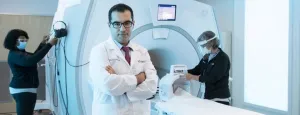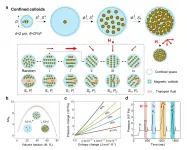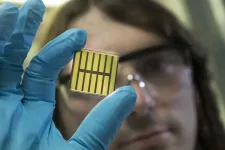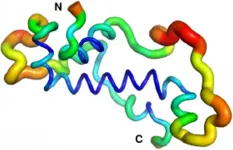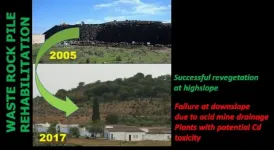Astronomers detect a black hole on the move
Astronomers have detected a moving supermassive black hole
2021-03-12
(Press-News.org) Scientists have long theorized that supermassive black holes can wander through space--but catching them in the act has proven difficult.
Now, researchers at the Center for Astrophysics | Harvard & Smithsonian have identified the clearest case to date of a supermassive black hole in motion. Their results are published today in the Astrophysical Journal.
"We don't expect the majority of supermassive black holes to be moving; they're usually content to just sit around," says Dominic Pesce, an astronomer at the Center for Astrophysics who led the study. "They're just so heavy that it's tough to get them going. Consider how much more difficult it is to kick a bowling ball into motion than it is to kick a soccer ball -- realizing that in this case, the 'bowling ball' is several million times the mass of our Sun. That's going to require a pretty mighty kick."
Pesce and his collaborators have been working to observe this rare occurrence for the last five years by comparing the velocities of supermassive black holes and galaxies.
"We asked: Are the velocities of the black holes the same as the velocities of the galaxies they reside in?" he explains. "We expect them to have the same velocity. If they don't, that implies the black hole has been disturbed."
For their search, the team initially surveyed 10 distant galaxies and the supermassive black holes at their cores. They specifically studied black holes that contained water within their accretion disks -- the spiral structures that spin inward towards the black hole.
As the water orbits around the black hole, it produces a laser-like beam of radio light known as a maser. When studied with a combined network of radio antennas using a technique known as very long baseline interferometry (VLBI), masers can help measure a black hole's velocity very precisely, Pesce says.
The technique helped the team determine that nine of the 10 supermassive black holes were at rest--but one stood out and seemed to be in motion.
Located 230 million light-years away from Earth, the black hole sits at the center of a galaxy named J0437+2456. Its mass is about three million times that of our Sun.
Using follow-up observations with the Arecibo and Gemini Observatories, the team has now confirmed their initial findings. The supermassive black hole is moving with a speed of about 110,000 miles per hour inside the galaxy J0437+2456.
But what's causing the motion is not known. The team suspects there are two possibilities.
"We may be observing the aftermath of two supermassive black holes merging," says Jim Condon, a radio astronomer at the National Radio Astronomy Observatory who was involved in the study. "The result of such a merger can cause the newborn black hole to recoil, and we may be watching it in the act of recoiling or as it settles down again."
But there's another, perhaps even more exciting possibility: the black hole may be part of a binary system.
"Despite every expectation that they really ought to be out there in some abundance, scientists have had a hard time identifying clear examples of binary supermassive black holes," Pesce says. "What we could be seeing in the galaxy J0437+2456 is one of the black holes in such a pair, with the other remaining hidden to our radio observations because of its lack of maser emission."
Further observations, however, will ultimately be needed to pin down the true cause of this supermassive black hole's unusual motion.
INFORMATION:
Co-authors of the new study are Anil Seth of the University of Utah; Jenny Greene of Princeton University; Jim Braatz, Jim Condon, and Brian Kent of the National Radio Astronomy Observatory; and Davor Krajnovi? of the Leibniz Institute for Astrophysics in Potsdam, Germany.
About the Center for Astrophysics | Harvard & Smithsonian
The Center for Astrophysics | Harvard & Smithsonian is a collaboration between Harvard and the Smithsonian designed to ask--and ultimately answer--humanity's greatest unresolved questions about the nature of the universe. The Center for Astrophysics is headquartered in Cambridge, MA, with research facilities across the U.S. and around the world.
[Attachments] See images for this press release:
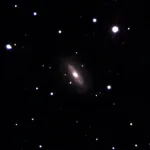
ELSE PRESS RELEASES FROM THIS DATE:
2021-03-12
Since the pandemic hit, researchers have been uncovering ways COVID-19 impacts other parts of the body, besides the lungs.
Now, for the first time, a visual correlation has been found between the severity of the disease in the lungs using CT scans and the severity of effects on patient's brains, using MRI scans. This research is published in the American Journal of Neuroradiology. It will be presented at the 59th annual meeting of the American Society of Neuroradiology (ASNR) and has also been selected as a semifinalist for that organization's Cornelius Dyke Award.
The results show that by looking at lung CT scans of patients diagnosed with COVID-19, physicians may be able to predict just how badly they'll experience other ...
2021-03-12
ITHACA, N.Y. - A new Penn State and Cornell study describes an effort to produce the most comprehensive and high-resolution map yet of chromosome architecture and gene regulation in yeast, a major step toward improving understanding of development, evolution and environmental responses in higher organisms.
Specifically, the study mapped precise binding sites of more than 400 different chromosomal proteins in the yeast genome, most of which regulate the expression of genes.
Yeast cells provide a simple model system with 6,000 genes, most of which are found in other organisms, including humans, making them excellent candidates for studying fundamental genetics and complex biological pathways.
The paper, "A High-Resolution Protein Architecture of the Budding Yeast ...
2021-03-12
Around three times as many males are diagnosed with autism than females. This suggests that biological sex factors may play a role in the development and presentation of autism.
Studies on the neurobiology (brain biology) of males and females with autism have begun to examine brain networks but results have been mixed. This is largely due to the limited availability of data from autistic females.
In response, researchers from END ...
2021-03-12
Humans rely on nature extensively for everything from food production to coastal protection, but those contributions might be more threatened than previously thought, according to new findings from the University of Colorado Boulder.
This research, out today in Nature Communications, looked at three different coastal food webs that include those services provided to humans, or ecosystem services, and found that even if the services themselves aren't directly threatened, they can become threatened when other species around them go extinct--often called secondary ...
2021-03-12
More than one million operations are performed in Switzerland every year. A surgeon's skill has a direct impact on the outcome of the operation. Training and experience, as well as momentary fatigue and other influencing factors all play a role. At present, skill is tested by experts, either directly during an operation or by evaluating video footage. This approach is very costly and only a limited number of experts are available. Moreover, the assessment may vary and is not always fully reproducible. For some time, attempts have been made to automate and objectify the assessment of surgeons' skills.
Proof of feasibility
The key result of the study is the proof of the fundamental feasibility of an ...
2021-03-12
Colloidal suspensions of microscopic particles show complex and interesting collective behaviors. In particular, the collective dynamics of colloids is fundamental and ubiquitous for materials assembly, robotic motion, microfluidic control, and in several biological scenarios. The collective dynamics of confined colloids can be completely different from that of free colloids: for instance, confined colloids can self-organize into vortex structures, coherent motion, or different phase behaviors. On one hand, due to the complexity of colloidal suspensions, how to finely tune the ...
2021-03-12
As the world continues to grapple with the COVID-19 pandemic, an international team of researchers have published a review of the best techniques to collect airborne aerosols containing viruses.
In the review, which was published by the Science of the Total Environment journal, a team led by the University of Surrey concluded that the most effective way to collect and detect airborne pathogens, particularly viruses, was to use cyclone sampling techniques.
For example, the sampler draws the air through the cyclone separator. It then uses centrifugal forces to collect the particles on a sterile cone containing the liquid collection vessel, such as DMEM (Dulbecco's minimal essential ...
2021-03-12
Photovoltaics decisively contributes to sustainable energy supply. The efficiency of solar cells in directly converting light energy into electrical energy depends on the material used. Metal-halide perovskites are considered very promising materials for solar cells of the next generation. With these semiconductors named after their special crystal structure, a considerable increase in efficiency was achieved in the past years. Meanwhile, perovskite solar cells have reached an efficiency of up to 25.5 percent, which is quite close to that of silicon ...
2021-03-12
Proteins are the key component in all modern forms of life. Haemoglobin, for example, transports the oxygen in our blood; photosynthesis proteins in the leaves of plants convert sunlight into energy; and fungal enzymes help us to brew beer and bake bread. Researchers have long been examining the question of how proteins mutate or come into existence in the course of millennia. That completely new proteins - and, with them, new properties - can emerge practically out of nothing, was inconceivable for decades, in line with what the Greek philosopher Parmenides said: "Nothing can emerge from nothing" (ex nihilo nihil fit). Working with colleagues from the USA and ...
2021-03-12
The Cabeza de los Gatos waste rock pile, left from mining activities in the town of Tharsis (Huelva), underwent a rehabilitation process consisting of remodelling the slope of the pile, applying liming materials and then a layer of soil. Finally, trees and shrubs typical of the area were planted and a hydroseeding with a mixture of shrub and herbaceous seeds was applied. Twelve years later, a study led by researchers from IRNAS-CSIC, in collaboration with Sabina Rossini Oliva, a researcher from the University of Seville and the Environment and Water Agency of Andalusia (AMAYA), has proven the effectiveness of this sort of rehabilitation.
"The results obtained show that the steps taken were successful. Now, ...
LAST 30 PRESS RELEASES:
[Press-News.org] Astronomers detect a black hole on the move
Astronomers have detected a moving supermassive black hole

